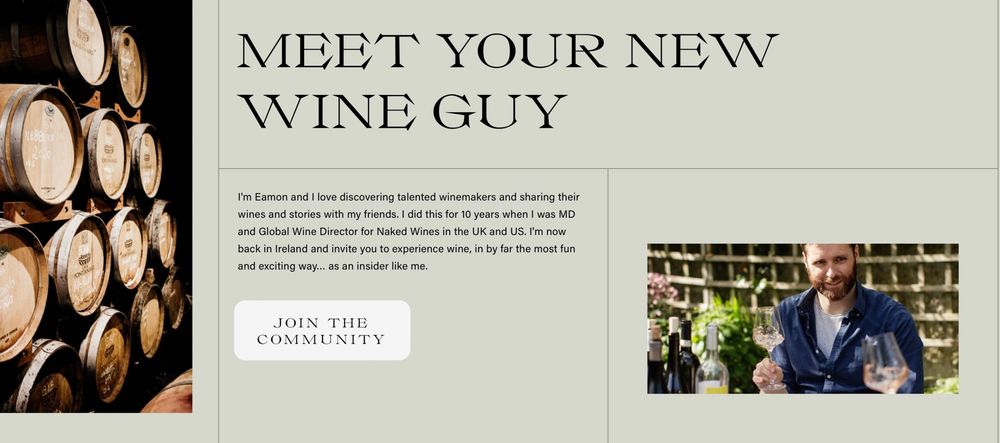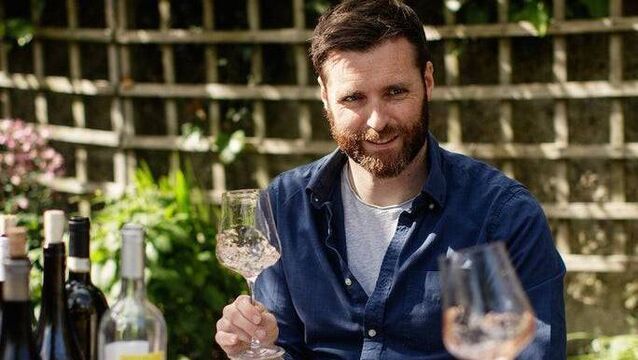The big quandary running an e-commerce website is how do you promote it and how much will it cost to do so? Eamon FitzGerald explains how he has managed to use email to drive a lot of the marketing and promotion for his new WineSpark online site.
When I launched WineSpark in July 2021, I knew I wanted to make premium wines accessible and affordable to Irish wine drinkers. I also knew I wanted to put every spare cent I had into the quality of the product and service. That way, the wines would (should?) do the talking for me. It meant I had to find alternative channels to paid marketing (online ads) to grow the business. And it turns out that it’s entirely possible. If you’re thinking about doing something similar – here’s how I did it:
1. Build a pre-launch landing page

The home page for Eamon FitzGerald’s new WineSpark website
The second you’ve decided on a brand name and URL – build a simple landing page and start capturing email addresses. Add a Whatsapp share button. Direct everyone you know to this page. Ask them to share it far and wide.
Make sure you capture the prospect’s first name as well as email. Hardly any websites do this, I don’t know why. You can then personalise your emails (Hi Eamon…) and get a free and easy uplift in conversion straight away. You’re welcome!
Two months from launch – I started sending one email per week to my list. I told my readers about my story, why I wanted to start the business, why I’d found a better way to buy wine. And dropped bits of exciting news as it happened, such as a new wine or winemaker I’d just landed.
A heartfelt and genuine tone, in plain-text emails, worked well for me. No need to spend anything on fancy design. Each email had a very clear call to action – if you like the sound of this, please forward this onto a friend.
By the time I’d launched, I had 1,500 emails on my list. And converted 10-15% of these into paying subscribers on day one.
Pre-launch nerves aside, it wasn’t a huge surprise. This was months in the making.
2. Get the word out through PR
I’ve been lucky to receive great support from journalists in Ireland. I’ve got a differentiated business model, one that genuinely delivers better value and they have recognised this. You’ll likely have two types of media to target – industry and business.
With business journalists – make sure your pitch is factual and newsworthy (launch, customer/sales milestones, funding etc). They tend to be more interested in the business and the people behind it, rather than the product.
With industry journalists, build relationships and offer samples where applicable. Know your product inside out and most of all, get your passion across. These people love the product as much as you do.
Focus on quality, not quantity of output. You can spend a lot of time and effort creating noise, and congratulating yourself for it. But in reality there’s only a small number of highly relevant journalists that appeal to your target audience.
3. Over-deliver on service

The personal touch is still important when running an online website says Eamon FitzGerald
Offering a 5-star service applies whether you’re Day 1 or Day 1,000. But in the early days – nothing will kill your brand faster than a poor first experience. There’ll be plenty of hiccups and delays along the way – make sure you communicate openly and honestly with your customers. They’ll give you rope because you’re new. As a wise man (Rowan Gormley) once said – ‘the best time to communicate is when you least feel like it!’
Don’t point the finger at your delivery company or whoever was at fault – drop everything and do whatever it takes to resolve it. There can be great moments too – delivering cases all over Dublin with my dad was one of the best days early on in the business.
4. Build mutually beneficial partnerships
Try and create a win-win situation with other companies – how can you craft a deal that achieves both your objective and that of a partner company? For example, you might want high-value customers. They might want the same, or to sell more stuff, or to reward their clients or employees.
Then build a sales pipeline – who are the companies with employees or clients that fit your target demographic? Who do you know or knows someone who works there?
I received amazing support from the likes of Goodbody, Accenture, A&L Goodbody, Grant Thornton, and many others. But they also got something from it too.
Conclusion
I want the quality of my product, not the effectiveness of my marketing, to be the fuel behind the growth of this company. If you want to go down the route of Facebook, Instagram or Google advertising go ahead, but be aware that it’s risky in the long-run – media costs are highly unpredictable, and you never own the customer data.
When you sell physical goods, every € you spend on advertising has to come out of the quality of the product, or the price goes up for your existing customers. That’s a sacrifice you should consider very carefully. Once you start dabbling in paid advertising, it’s impossible to stop. A bit like good white Burgundy…
The next 1,000? Well that’s an entirely different story. Stay tuned for the next installment.
And while you’re here, if you’d like to join our 1,000-strong community and drink better wine, you can become a WineSpark member here.









































